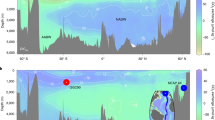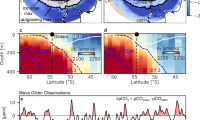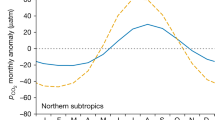Abstract
The effect of hurricanes on the thermal and physical structure of the upper ocean has been described1 but their influence on the ocean carbon cycle and the exchange of carbon between ocean and atmosphere is not well understood. Here we present observations from the Sargasso Sea, before and after hurricane Felix in summer 1995, that show a short-lived (2–3 weeks) surface seawater cooling of about 4 °C, and a decrease in seawater partial pressure of CO2 by about 60 µatm. Despite the localized decrease in seawater partial pressure of CO2, strong winds during the passage of hurricane Felix increased the efflux of CO2 from ocean to atmosphere. We estimate that hurricane Felix and two other hurricanes increased the summertime efflux of CO2 into the atmosphere over this part of the Sargasso Sea by nearly 55%. We estimate that hurricanes contribute to the global ocean-to-atmosphere flux of CO2 by between +0.04 to +0.51 Pg C (1015 g C) per year. Such hurricane-forced effluxes are quantitatively significant compared to regional (14° to 50° N zone)2 and global effluxes2,3. Hurricanes therefore exert an important influence on ocean–atmosphere CO2 exchange and the inferred4 year-to-year variability of CO2 fluxes over the subtropical oceans.
This is a preview of subscription content, access via your institution
Access options
Subscribe to this journal
Receive 51 print issues and online access
$199.00 per year
only $3.90 per issue
Buy this article
- Purchase on Springer Link
- Instant access to full article PDF
Prices may be subject to local taxes which are calculated during checkout

Similar content being viewed by others
References
Stramma, L., Cornillon, P. & Price, J. F. Large diurnal sea surface temperature variability: satellite and in situ measurements. J. Geophys. Res. 91, 5031–5035 (1986).
Takahashi, T. et al. Global air-sea flux of CO2: An estimate based on measurements of sea-air p CO 2 difference. Proc. Natl Acad. Sci. USA 94, 8292–8299 (1997).
Tans, P. P., Fung, I. Y. & Takahashi, T. Observational constraints on the global atmospheric CO2 budget. Science 247, 1431–1438 (1990).
Ciais, P. et al. Partitioning of ocean and land uptake of CO2 as inferred by δ13C measurements from the NOAA Climate Monitoring and Diagnostics Laboratory Global Air Sampling Network. J. Geophys. Res. 100(D3), 5051–5070 (1995).
Takahashi, T., Olafsson, J., Goddard, J., Chipman, D. W. & Sutherland, S. C. Seasonal variation of CO2 and nutrients in the high-latitude surface oceans: a comparative study. Glob. Biogeochem. Cycles 7, 843–878 (1993).
Millero, F. J. The thermodynamics of the carbonic acid system in seawater. Geochim. Cosmochim. Acta 59, 661–677 (1995).
Codispoti, L. A., Friederich, G. E. & Hood, D. W. Variability in the inorganic carbon system over the southeastern Bering Sea shelf during spring 1980 and spring-summer 1981. Continent. Shelf Res. 5, 133–160 (1986).
Watson, A. J., Robinosn, C., Robertson, J. E., leB. Williams, P. J. & Fasham, M. J. R. Spatial variability in the sink for atmospheric carbon dioxide in the North Atlantic. Nature 350, 50–53 (1991).
Bates, N. R., Michaels, A. F. & Knap, A. H. Alkalinity changes in the Sargasso Sea: Geochemical evidence of calcification? Mar. Chem. 51, 347–358 (1996).
Bates, N. R., Michaels, A. F. & Knap, A. H. Seasonal and interannual variability of the oceanic carbon dioxide system at the U.S. JGOFS Bermuda Atlantic Time-series Site. Deep-Sea Res. II 42, 347–383 (1996).
Menzel, D. W. & Ryther, J. H. The annual cycle of primary production in the Sargasso Sea off Bermuda. Deep-Sea Res. 6, 351–367 (1960).
Lohrenz, S. E. et al. Seasonal variability in primary production and particle flux in the northwestern Sargasso Sea: U.S. JGOFS Bermuda Atlantic Time-series Study. Deep-Sea Res. 39, 1373–1391 (1992).
Michaels, A. F. et al. Seasonal patterns of ocean biogeochemistry at the U.S. JGOFS Bermuda Atlantic Time-series Study site. Deep-Sea Res. I 41, 1013–1038 (1994).
Nelson, N. B. The wake of Hurricane Felix. Int. J. Remote Sensing 17, 2893–2895 (1996).
Dickey, T. D. et al. Preliminary results from the Bermuda Testbed Mooring Program. Deep-Sea Res. I (in the press).
Bates, N. R., Takahashi, T., Chipman, D. W. & Knap, A. H. Variability of p CO 2 on diel to seasonal timescales in the Sargasso Sea near Bermuda. J. Geophys. Res. (in the press).
Liss, P. S. & Merlivat, L. in The Role of Air-Sea Exchange in Geochemical Cycling (ed. Buat-Menard, P.) 113–128 (NATO ASI Ser. C 185, Springer-Verlag, Berlin, (1986)).
Wanninkhof, R. Relationship between wind speed and gas exchange over the ocean. J. Geophys. Res. 97, 7373–7380 (1992).
Feely, R. A. et al. The effect of tropical instability waves on CO2 distributions along the equator in the eastern equatorial Pacific during the 1992 ENSO event. Geophys. Res. Lett. 21, 277–280 (1994).
Feely, R. A. et al. CO2 distributions in the equatorial Pacific during the 1991–1992 ENSO event. Deep-Sea Res. II 42, 387–409 (1995).
Wanninkhof, R. et al. Seasonal and lateral variations in carbon chemistry of surface water in the eastern equatorial Pacific during 1992. Deep-Sea Res. II 42, 387–409 (1995).
Sarmiento, J. L., Hughes, T. M. C., Stouffer, R. J. & Manabe, S. Simulated response of the ocean carbon cycle to anthropogenic climate warming. Nature 393, 245–249 (1998).
Henderson-Sellers, A. & Zhang, H. Tropical Cyclones and Global Climate Change (WMO/CAS/TMRP Committee on Climate Change Assessment (Project TC-2), World Meteorological Organization Rep. New York, NY, (1997)).
Weiss, R. F. Carbon dioxide in water and seawater; the solubility of a non-ideal gas. Mar. Chem. 2, 203–215 (1974).
Chipman, D. W., Marra, J. & Takahashi, T. Primary production at 47° N and 20° W in the North Atlantic Ocean: a comparison between the 14C incubation method and the mixed layer carbon budget. Deep-Sea Res. 40, 151–169 (1993).
Peng, T.-H., Takahashi, T., Broecker, W. S. & Olafsson, J. Seasonal variability of carbon dioxide, nutrients and oxygen in the northern North Atlantic surface water: observations and a model. Tellus B 39, 439–458 (1987).
Dickson, A. G. & Goyet, C. (eds) Handbook of Methods for the Analysis of the Various Parameters of the Carbon Dioxide System in Seawater Version 2 (US Department of Energy CO2Science Team Report, Washington DC, (1994)).
Goyet, C. & Poisson, A. P. New determination of carbonic acid dissociation constants in seawater as a function of temperature and salinity. Deep-Sea Res. 36, 1635–1654 (1989).
Roy, R. N. et al. Determination of the ionization constants of carbonic acid in seawater. Mar. Chem. 44, 249–268 (1993).
Acknowledgements
We thank T. Takahashi and D. W. Chipman for their assistance and support in measuring ; the crew of RV Weatherbird II; J. Benson, F. Howse, B. Bjork, M. Church, S. Becker and R.Little for their shipboard assistance; D. Frye and T. D. Dickey for wind data from the Bermuda Testbed Mooring Program; D. Ollis and R. Parkes for wind and air temperature data from the former US Naval Station and Bermuda Harbour Radio, respectively; N. B. Nelson and R. J. Johnson for satellite and CTD data; F. Bahr for processing thermosalinograph data; and D. A. Hansell and C. A. Carlson for their reviews. This research was supported by NSF.
Author information
Authors and Affiliations
Corresponding author
Rights and permissions
About this article
Cite this article
Bates, N., Knap, A. & Michaels, A. Contribution of hurricanes to local and global estimates of air–sea exchange of CO2. Nature 395, 58–61 (1998). https://doi.org/10.1038/25703
Received:
Accepted:
Issue Date:
DOI: https://doi.org/10.1038/25703
This article is cited by
-
Upper Ocean Response to The Passage of Cyclone Tauktae in The Eastern Arabian Sea Using In Situ and Multi-Platform Satellite Data
Journal of the Indian Society of Remote Sensing (2023)
-
Modifications in the trace gases flux by a very severe cyclonic storm, Hudhud, in the coastal Bay of Bengal
Journal of Earth System Science (2019)
-
Mesoscale and submesoscale mechanisms behind asymmetric cooling and phytoplankton blooms induced by hurricanes: a comparison between an open ocean case and a continental shelf sea case
Ocean Dynamics (2018)
-
Time series changes in sea-surface temperature, chlorophyll a, nutrients, and sea-wind in the East/Japan Sea on the left- and right-hand sides of typhoon shanshan’s track
Ocean Science Journal (2010)
-
Do we have enough pieces of the jigsaw to integrate CO2 fluxes in the coastal ocean?
Estuaries (2005)
Comments
By submitting a comment you agree to abide by our Terms and Community Guidelines. If you find something abusive or that does not comply with our terms or guidelines please flag it as inappropriate.



